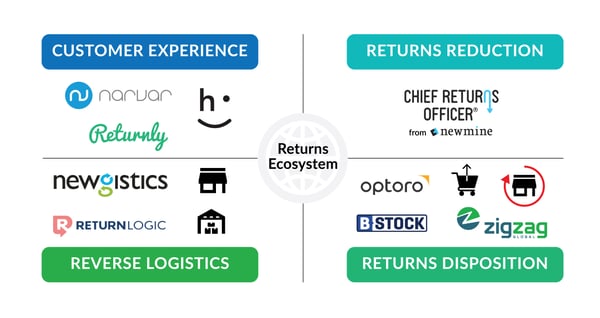Why Retailers Need a Chief Returns Officer
Which retail department is most impacted by returns?
With retailers coping with returns valued at a whopping $369 Billion in 2018, the industry is finally coming to terms with the fact they must face the returns bullet. The overall cost of product returns to a business is a bit uncertain, given that only 30% of retailers quantify the full-cost of returns. To quantify the full cost of returns to your business, you must consider:
- Labor: Every return is touched by >7 people during processing.
- Operations: Costs associated with processing, shipping, and storage. For example, on average, returns processing costs retailers $3 per package, up to $6 per return when shipped to a distribution center, or up to $8 per return when handled by a 3rd party.
- Inventory: Markdowns, refurbishment, disposition, and negative margin impact
- Customer Churn: While instituting a return policy that’s fast, free, and easy for customers is a sales motivator, customers who are compelled to return multiple times eventually stop shopping with that retailer.
With all this in mind, one can see why returns are such a significant detractor to a retailer’s bottom line health. Though crunching the relevant numbers we have determined that for every $1 MM in customer returns, retailers can lose $0.5 MM to the bottom line. If a retailer’s mission is to profitably deliver a product that both resonates and sticks, then reducing the volume of returned merchandise is a critical goal to improve net margin.
The Returns Challenge Demands Executive Ownership
Returns are an enterprise-wide problem that impact every facet of the retailer’s business, from product development through customer interaction. The reality is that the current state of returns management tends to be siloed. Each business area is responsible for their piece of the successful development, marketing, and delivery of products that a customer is thrilled to keep. Yet products are returned for a multitude of reasons, and there is no single “owner” that oversees every aspect of the return lifecycle or mitigation. According to a study of retailers we conducted in conjunction with the Retail Value Chain Federation, lack of returns ownership was cited as a significant obstacle to implementing and executing an initiative that embraces the entire returns problem—and opportunity.
Retailers would be wise to designate a “Chief Returns Officer” in their organization. A Chief Returns Officer would be an executive responsible for unifying silos under a shared vision to both reduce the number of returns and optimize the returns management process for products that do come back. This executive’s mission should include the following approach:
- Institute an overall strategy that focuses on three key objectives: 1) Achieving returns reduction, 2) Optimizing current returns management processes, and 3) Identifying margin-improving returns disposition alternatives.
- Designate relevant returns reduction and management departmental leaders across the enterprise to support focus and accountability to achieve returns reduction and performance metrics. Our recommendation is to create a team that is composed of veteran employees from merchandising, digital, marketing, supply chain, and finance.
- Leverage technology and experience. All team members must understand the root cause reasons for returns in order to reduce them. Technology, especially AI is essential to provide the necessary actionable insights, problem identification, and collaboration to support the overall strategy. With relevant data emanating real-time from many sources, only technology can orchestrate a single version of the truth, enable teams to understand the big picture of their returns problem and provide targeted action based on root cause. AI-driven technology, in concert with experienced business users, is the key to establishing a sustainable, scalable, and affordable means to tackle the returns issue.
To successfully execute a returns reduction and management strategy, the Chief Returns Officer should have a broad knowledge of the entire product management and return lifecycle. This includes the requisite knowledge to structure a program that incorporates the key elements of sourcing, quality control, operations, shipping, customer return policies, root cause tracking, refurbishment, and remarketing.
So, who best fills your company’s role as Chief Returns Officer?
Which executive best fits the profile and skill set described here? Ultimately, when it comes to the bottom-line impact of returns, the buck stops with the CEO and CFO. This is a logical place to start, however, we can also build a case for the COO or GMM as solid candidates for this position. No matter which member of your C-Suite assumes the mantle, the good news is that there is an entire ecosystem of returns reduction and returns management partners that are geared to helping retailers to execute an effective returns strategy.

The Returns Reduction and Management Ecosystem
Returns Reduction: A returns reduction platform utilizes AI-based technology to quickly and efficiently identify in-season return issues, root cause return reasons, and provide retailers with a collaborative and experience-driven means to take the necessary actions to reduce return rates. The dynamic combination of product, supplier, and customer-centric returns intelligence can save retailers millions in related operational and lost customer costs.
Customer Experience Solutions: These partners focus on ensuring that customers have a simple, streamlined returns experience.
Reverse Logistics Solutions: These companies focus on optimization of the return transaction and product handling processes.
Returns Disposition: No retailer can eliminate returns entirely. These companies enter the picture once you’ve processed the return. Their role is to help retailers to minimize markdown losses, refurbish, remarket, or liquidate the merchandise.
Customer returns show no sign of lessening or becoming less expensive for retailers, especially as digital channels continue their growth. In order to stem the tide of returns related bottom line erosion, every company needs a Chief Returns Officer. And every Chief Returns Officer needs Chief Returns Officer—The industry’s ONLY AI-driven Returns Reduction Platform.